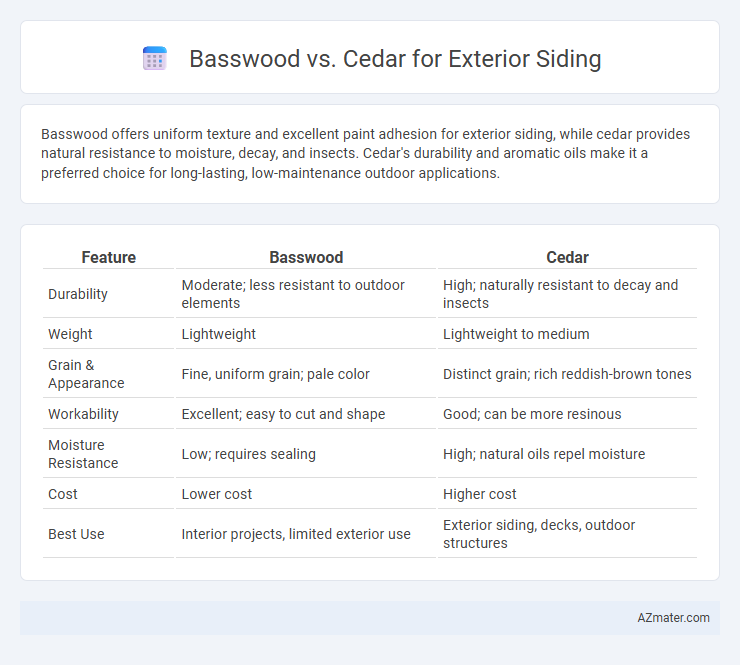Basswood offers uniform texture and excellent paint adhesion for exterior siding, while cedar provides natural resistance to moisture, decay, and insects. Cedar's durability and aromatic oils make it a preferred choice for long-lasting, low-maintenance outdoor applications.
Table of Comparison
| Feature | Basswood | Cedar |
|---|---|---|
| Durability | Moderate; less resistant to outdoor elements | High; naturally resistant to decay and insects |
| Weight | Lightweight | Lightweight to medium |
| Grain & Appearance | Fine, uniform grain; pale color | Distinct grain; rich reddish-brown tones |
| Workability | Excellent; easy to cut and shape | Good; can be more resinous |
| Moisture Resistance | Low; requires sealing | High; natural oils repel moisture |
| Cost | Lower cost | Higher cost |
| Best Use | Interior projects, limited exterior use | Exterior siding, decks, outdoor structures |
Introduction: Basswood vs Cedar for Exterior Siding
Basswood and cedar are popular choices for exterior siding, each offering unique benefits. Basswood is known for its smooth texture and uniform grain, making it ideal for detailed finishes, while cedar provides natural resistance to decay and insects due to its aromatic oils. The selection between basswood and cedar hinges on factors like durability, maintenance, and aesthetic preferences in exterior applications.
Overview of Basswood and Cedar
Basswood is a lightweight, fine-grained hardwood known for its smooth texture and ease of machining, making it ideal for detailed exterior siding work. Cedar, particularly Western Red Cedar, offers natural resistance to rot, decay, and insect damage due to its high concentrations of natural oils, which enhances its durability for outdoor use. Both woods provide aesthetic appeal, but cedar's superior weather resistance makes it a preferred choice for long-lasting exterior cladding.
Durability and Weather Resistance
Basswood offers moderate durability and requires regular maintenance to withstand exterior weather conditions, as it is prone to moisture damage and insect infestation if untreated. Cedar provides superior weather resistance with natural oils that repel moisture, insects, and decay, making it a more durable option for exterior siding in varying climates. Both woods benefit from proper sealing, but cedar's inherent resistance makes it the preferred choice for long-lasting, low-maintenance exterior applications.
Appearance and Aesthetic Qualities
Basswood exterior siding offers a smooth, fine-grain texture with a pale, creamy color that easily accepts stains and paints, creating a versatile, clean appearance ideal for modern or traditional homes. Cedar siding is prized for its rich, natural hues ranging from reddish-brown to golden tones, along with its pronounced grain and knots that add character and a rustic, warm aesthetic to exterior facades. Both wood types provide distinct visual appeal, with basswood favored for uniformity and cedar chosen for its natural beauty and aging qualities.
Maintenance Requirements
Basswood exterior siding demands frequent sealing and painting to prevent moisture damage and maintain its appearance, especially in humid or rainy climates. Cedar siding naturally resists rot and insect infestation due to its natural oils, significantly reducing maintenance frequency and typically requiring only occasional staining or sealing. Choosing cedar siding results in lower long-term upkeep costs and better durability for exterior applications.
Insulation and Energy Efficiency
Basswood offers moderate insulation properties due to its relatively low density, making it less effective at retaining heat compared to denser woods. Cedar, known for its natural resistance to moisture and decay, provides superior thermal insulation, helping maintain consistent indoor temperatures and enhancing energy efficiency. Choosing cedar siding can reduce heating and cooling costs by minimizing thermal bridging and improving overall exterior wall performance.
Cost Comparison
Basswood siding generally costs between $3 to $7 per square foot, making it a more budget-friendly option compared to cedar. Cedar siding prices range from $6 to $10 per square foot, reflecting its natural resistance to decay and insect damage. While basswood requires more maintenance to protect against moisture, cedar's higher upfront cost is often offset by its longevity and reduced upkeep expenses.
Environmental Impact and Sustainability
Basswood exterior siding offers a lower environmental impact due to its rapid growth rate and renewable qualities, making it a sustainable choice for eco-conscious builders. Cedar, while more durable and naturally resistant to decay, often comes from slower-growing sources which can contribute to deforestation if not sourced responsibly. Choosing FSC-certified cedar or sustainably harvested basswood ensures reduced carbon footprint and promotes long-term forest health in exterior siding applications.
Installation Considerations
Basswood offers a smooth surface that is easy to paint and shape, making it ideal for detailed exterior siding installations, but it requires careful sealing to prevent moisture damage. Cedar naturally resists decay and insects, reducing maintenance needs and simplifying installation in harsh climates due to its dimensional stability. Both woods demand proper ventilation and moisture barriers during installation to ensure longevity and performance.
Pros and Cons Summary
Basswood siding offers a smooth texture and excellent paint adhesion, making it ideal for custom finishes, but it has lower natural durability and requires regular maintenance to prevent decay. Cedar siding provides superior resistance to moisture, decay, and insect damage due to its natural oils, resulting in longer lifespan and less frequent upkeep, though it is generally more expensive and can warp or check over time. Both options benefit from proper sealing and maintenance to maximize longevity and aesthetic appeal in exterior applications.

Infographic: Basswood vs Cedar for Exterior Siding
 azmater.com
azmater.com